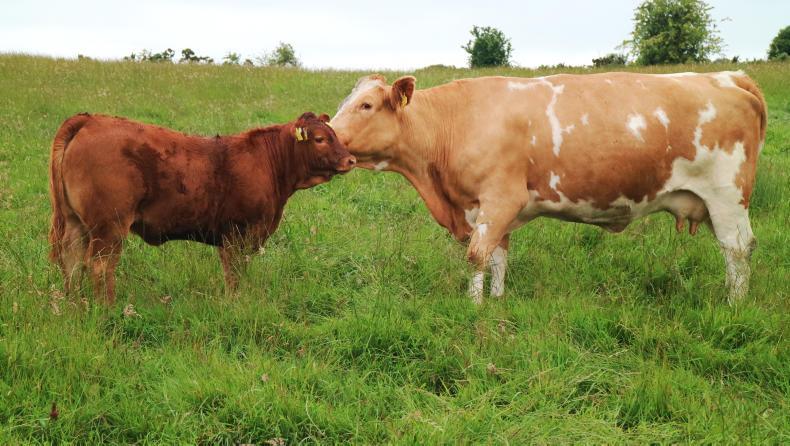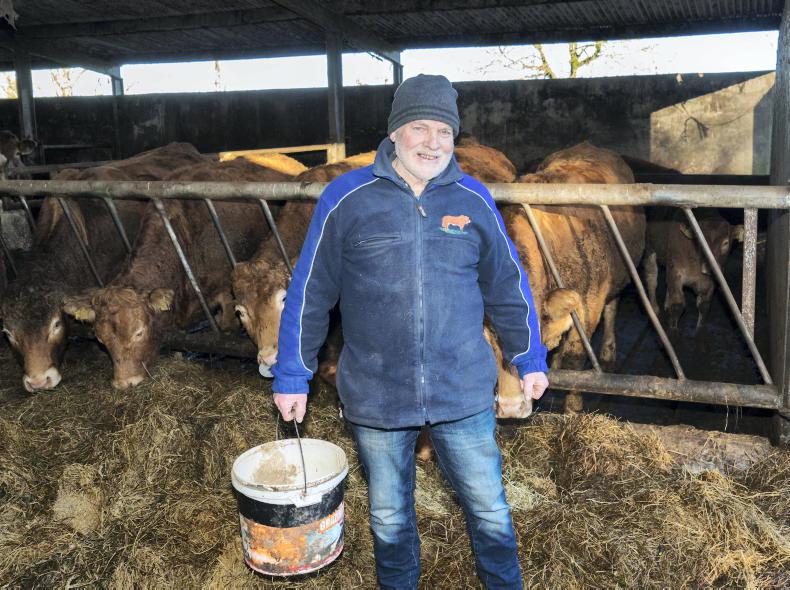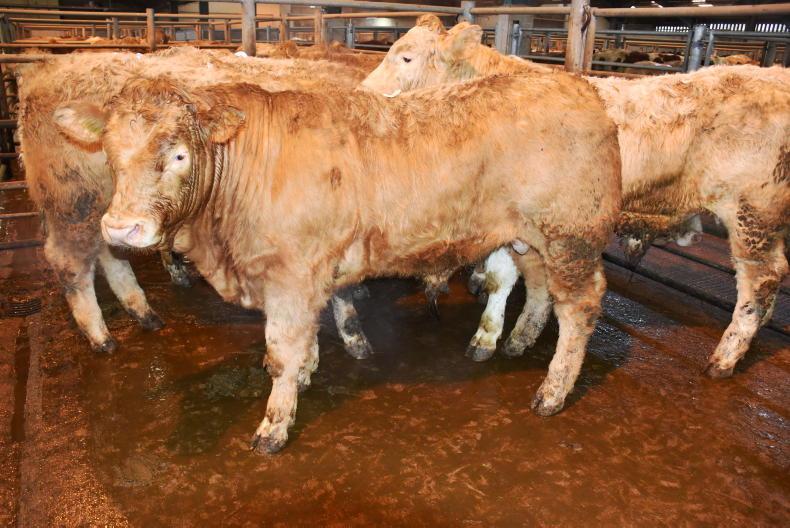Brendan Grehan farms in partnership with his father, John, in Taughmaconnell, 10km north of Ballinasloe across the Roscommon border.

Brendan and John Grehan.
The family runs a herd of 18 suckler cows producing weanlings for sale in the back end of the year, alongside a flock of 55 ewes on a 19ha farm. Brendan works full-time with local contractor Enda Kelly while John works on road maintenance with Roscommon County Council.
Limousin
The breed of choice on the farm is Limousin. The current stock bull has just had his second crop of calves hit the ground this spring and Brendan is happy with what he is producing. The bull, Glen-More Luck, is sired by Ampertaine Commander and with a replacement index of €106 and a terminal index figure of €127 is putting great length and shape into his offspring.
The layout of the farm doesn’t lend itself to getting cows in for serving with much of the grazing across the road from the main yard
Brendan explained: “We have been Limousin for a lot of years here and we are very happy with the breed. You have a good saleable calf come October time. With both of us working off-farm, calving ease means a lot – most are unassisted at calving. Working off-farm means a good stock bull saves a lot of time. In the past, we have tried AI but found the calving spread was increasing year on year as we weren’t here to see cows during the day. Also, the layout of the farm doesn’t lend itself to getting cows in for serving with much of the grazing across the road from the main yard.”

The farm stock bull Glen-More Luck with some of his 2020 offspring.
Although the stock bull is producing some really nice-quality heifers that would make super replacements, the Grehans avoid the temptation to breed any of their own heifers.
“There are times you look at a heifer and would like to breed from her alright, but it would complicate things as you would have to be changing the bull every couple of years and we don’t want to do that. The last bull we had was on the farm for nearly a decade and hopefully we will get something similar from this bull if he’s lucky.”
Therefore all replacements are bought in either through the mart or sometimes through private sales.
“We like to buy cows with calves at foot – at least that way you know she’s able to have a calf and she knows what to do. Last year, we bought two Simmental cows with calves at foot and they have great calves off our bull this year. We are in the BEAM scheme so there were no purchases this year. We are just watching numbers to make sure we meet the 5% reduction targets.”
Calving
Calving starts in early March and is usually finished by the end of May. Operating a weanling system, the Grehans want to get calves on the ground as soon as possible to leave a heavy enough animal for sale in October.
Winter housing is quite tight
Last year, there were five heifer calves held over as they were slightly younger and too light for sale.
“Winter housing is quite tight. We can hold a small number of weanlings over winter, if needed, but not all. It can be difficult in years where weanling prices are bad. You don’t have much choice but to take the price you are being offered. The heifers that were wintered have done well. We have grazed them this summer as well and they will be sold in the mart in the coming weeks.”
Sheep
In order to overcome the shortage of winter housing, there is a flock of around 55 Suffolk and Mule cross ewes on the farm. Lambing begins around 25 January each year with Texel and Charollais rams used for breeding.
“We have always operated an early-season lambing system. It works as we can have all ewes lambed before the start of calving. Depending on the weather, ewes will be housed on a dry floor shed about a fortnight prior to lambing.
Once they lamb down, they are back outside within 24 hours as long as the weather is good enough
“We will be feeding meal outside from December onwards. Once they lamb down, they are back outside within 24 hours as long as the weather is good enough. This spring was difficult as it was just so wet. We were trying to hold ewes and lambs up for a couple of days to let the lambs get stronger.”
Once up and running, the lambs never look back and Brendan is down to just seven lambs to sell at this point.
“It has been a super year for selling lambs – most of ours go to the local butcher.
“I’d say we’ll have averaged almost €120/head this year, so there is nothing wrong with that.”
Reseeding
Currently, the ewes are grazing a 5ac field quite tight as Brendan and John hope to get it reseeded in the coming weeks.
Much of the farm has been reseeded over the years apart from where the cows and calves are grazing, which is low-input permanent pasture as part of GLAS.
I asked the lads if I was to put another shed in the yard in the morning would they sell the sheep and run another 10 or 12 cows instead? “There always seems to be another job needing to be done with the sheep – a lot of time and work goes into them. However, I don’t think we’d sell all the sheep and replace them with cows. I could see us increasing cows by another six or eight and running 30 ewes.
The sheep are great this time of year to run after the cow and clean out paddocks
“That would give us more space over the winter and more options for the weanlings if we wanted to keep a few more. The sheep are great this time of year to run after the cow and clean out paddocks,” John explained.
“I think the system we have is operating quite well. There are always things you would like to improve on each year. We feel we are breeding a good commercial animal that has good growth potential for the next farmer. A couple of good days out in Ballinasloe Mart this autumn will hopefully confirm that again this year,” Brendan concluded.
Brendan Grehan farms in partnership with his father, John, in Taughmaconnell, 10km north of Ballinasloe across the Roscommon border.

Brendan and John Grehan.
The family runs a herd of 18 suckler cows producing weanlings for sale in the back end of the year, alongside a flock of 55 ewes on a 19ha farm. Brendan works full-time with local contractor Enda Kelly while John works on road maintenance with Roscommon County Council.
Limousin
The breed of choice on the farm is Limousin. The current stock bull has just had his second crop of calves hit the ground this spring and Brendan is happy with what he is producing. The bull, Glen-More Luck, is sired by Ampertaine Commander and with a replacement index of €106 and a terminal index figure of €127 is putting great length and shape into his offspring.
The layout of the farm doesn’t lend itself to getting cows in for serving with much of the grazing across the road from the main yard
Brendan explained: “We have been Limousin for a lot of years here and we are very happy with the breed. You have a good saleable calf come October time. With both of us working off-farm, calving ease means a lot – most are unassisted at calving. Working off-farm means a good stock bull saves a lot of time. In the past, we have tried AI but found the calving spread was increasing year on year as we weren’t here to see cows during the day. Also, the layout of the farm doesn’t lend itself to getting cows in for serving with much of the grazing across the road from the main yard.”

The farm stock bull Glen-More Luck with some of his 2020 offspring.
Although the stock bull is producing some really nice-quality heifers that would make super replacements, the Grehans avoid the temptation to breed any of their own heifers.
“There are times you look at a heifer and would like to breed from her alright, but it would complicate things as you would have to be changing the bull every couple of years and we don’t want to do that. The last bull we had was on the farm for nearly a decade and hopefully we will get something similar from this bull if he’s lucky.”
Therefore all replacements are bought in either through the mart or sometimes through private sales.
“We like to buy cows with calves at foot – at least that way you know she’s able to have a calf and she knows what to do. Last year, we bought two Simmental cows with calves at foot and they have great calves off our bull this year. We are in the BEAM scheme so there were no purchases this year. We are just watching numbers to make sure we meet the 5% reduction targets.”
Calving
Calving starts in early March and is usually finished by the end of May. Operating a weanling system, the Grehans want to get calves on the ground as soon as possible to leave a heavy enough animal for sale in October.
Winter housing is quite tight
Last year, there were five heifer calves held over as they were slightly younger and too light for sale.
“Winter housing is quite tight. We can hold a small number of weanlings over winter, if needed, but not all. It can be difficult in years where weanling prices are bad. You don’t have much choice but to take the price you are being offered. The heifers that were wintered have done well. We have grazed them this summer as well and they will be sold in the mart in the coming weeks.”
Sheep
In order to overcome the shortage of winter housing, there is a flock of around 55 Suffolk and Mule cross ewes on the farm. Lambing begins around 25 January each year with Texel and Charollais rams used for breeding.
“We have always operated an early-season lambing system. It works as we can have all ewes lambed before the start of calving. Depending on the weather, ewes will be housed on a dry floor shed about a fortnight prior to lambing.
Once they lamb down, they are back outside within 24 hours as long as the weather is good enough
“We will be feeding meal outside from December onwards. Once they lamb down, they are back outside within 24 hours as long as the weather is good enough. This spring was difficult as it was just so wet. We were trying to hold ewes and lambs up for a couple of days to let the lambs get stronger.”
Once up and running, the lambs never look back and Brendan is down to just seven lambs to sell at this point.
“It has been a super year for selling lambs – most of ours go to the local butcher.
“I’d say we’ll have averaged almost €120/head this year, so there is nothing wrong with that.”
Reseeding
Currently, the ewes are grazing a 5ac field quite tight as Brendan and John hope to get it reseeded in the coming weeks.
Much of the farm has been reseeded over the years apart from where the cows and calves are grazing, which is low-input permanent pasture as part of GLAS.
I asked the lads if I was to put another shed in the yard in the morning would they sell the sheep and run another 10 or 12 cows instead? “There always seems to be another job needing to be done with the sheep – a lot of time and work goes into them. However, I don’t think we’d sell all the sheep and replace them with cows. I could see us increasing cows by another six or eight and running 30 ewes.
The sheep are great this time of year to run after the cow and clean out paddocks
“That would give us more space over the winter and more options for the weanlings if we wanted to keep a few more. The sheep are great this time of year to run after the cow and clean out paddocks,” John explained.
“I think the system we have is operating quite well. There are always things you would like to improve on each year. We feel we are breeding a good commercial animal that has good growth potential for the next farmer. A couple of good days out in Ballinasloe Mart this autumn will hopefully confirm that again this year,” Brendan concluded.












SHARING OPTIONS